Friend, Robert (McKechnie Section 2)
First discussed in print in an article ('A Family in Silhouette', Connoisseur, December 1924) by Mr F. Gordon Roe.
In about 1922 Mr Roe inherited from an `aged relative' a number of silhouettes, five of which had been packed away in an envelope and were said to represent members of the Friend family in Tunbridge Wells. These five, presented by Mr Roe to the Victoria and Albert Museum, London, are all illustrated in the present book. Two of them bore signatures such as 'Rob. Friend, T. Wells', or `Friend, Tunb. Wells'. From the style of the costume, they all appear to date from 1777-85. At this time Tunbridge Wells was becoming a residential town of some importance, but no other early silhouette artist appears to have made the town his centre. Friend may have painted these silhouettes of his family while an amateur. Since their discovery, however, further examples dating from c. 1785 to c. 1790, bearing printed trade labels, have come to light, which indicates that Friend had by now decided to put his talent to professional use.
799,800
In Mr Roe's article, cited above, is an illustration of a profile by Edward Foster of a Mr Robert Friend, which appears to have been taken c. 1815-25. A daughter of this Friend lived at some time in Derby, and it is possible that Foster painted the silhouette (which may indeed represent the silhouette artist Robert Friend) while Friend was in Derby staying with his daughter. The profile shows a man aged between fifty and sixty. Friend's daughter, Elizabeth Anne, married in 1827 William Gordon Plees (1805¬1887). Two profiles of their children were taken by the North country artist Maginn, and one of these (taken in Hull) is illustrated under the name of that artist in Section One.
529
As I have seen no profile by Friend which appears to date from after 1790, I assume that he worked in some other field in later years. If the silhouette by Foster does indeed represent this Robert Friend, which seems more than likely, he would perhaps have been about fifty-five years old in 1820, and would therefore have been born in c. 1765. This would indicate that the early profiles of c. 1780 were painted when Friend was in his teens; this supposition is strengthened by the unformed writing of the signature 'Friend, Tunbridge Wells', inscribed on the reverse of another profile in the Victoria and Albert Museum, taken during the early 1780s. It is strange that this roughly pencilled scrawl differs so markedly from the neat signatures written on the front of Friend's other early silhouettes.
801
It is unfortunate that not much identified work by this artist exists in private collections at the present Lime, though, if he really did cease work in c. 1790, this situation is understandable. Labelled works by Friend are rare. There is one example (illustrated) in the Christie collection. Another was sold by Sotheby and Company, London, on 26 March 1962; it was a profile, 3¼ in. in height, of a man. Another, sold at the same auction house on 9 May 1966, was apparently labelled. One more, mentioned by Mr J. A. Pollak ('Fresh Light on Silhouette', Connoisseur, March 1949), bore Trade Label No. 2.
802
Friend's early work (which seems to have been discovered unframed) was painted on rectangular pieces of card in Indian ink, thinned where necessary to show transparency and occasionally touched with a little Chinese white. Profiles dating from after c. 1785, when he is thought to have become a professional artist, were housed in the usual hammered brass frames of the 1780s.
The illustrated examples give an idea of the precision with which many of Friend's profiles were painted. During the 1780s, men often wore pigtail wigs, and Friend is one of the artists who show the diagonal binding of these wigs. Men's waistcoats (ignored, for instance, by most painters on plaster, with the exception of John Smith) are shown by thinned ink on Friend's silhouettes. He rendered shirt-frills in the various styles which are evident in the illustrations. Decorative detail on women's clothing, especially on the head-dress and at the bosom, he painted as well as Torond, using several depths of shading. The hanging curl on the shoulder, fashionable during the early 1780s, is nearly always shown.
Bust-line terminations vary. One of the illustrated silhouettes terminates in a roughly shaded base on which the artist has written his signature (not his usual practice).
800
Friend's early silhouettes were often signed beneath the bust-line, and in a variety of ways, as I have mentioned: `Friend, Tunb. Wells', 'Rob. Friend, T. Wells', and `Friend, Tunbridge Wells'. One example, which I have illustrated, is signed beneath the bust-line and has a trade label on the reverse.
803, 802
Two trade labels of Friend are known. No. 1 is on the reverse of a profile of a man taken in c. 1786-88. We can assume, therefore, that by this time Friend was a professional profilist. No. 2, recorded by Pollak, reads, `Taken by R. Friend, Tunbridge Wells, at 8s and 6d each, frame and glass Included
805
Ills. 796-805, 993
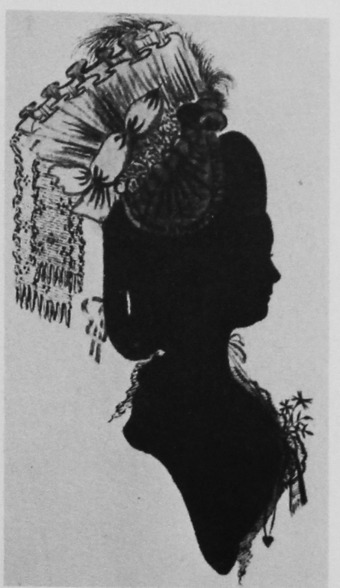
Woman, name unknown, member of the artist’s family
Silhouette painted on card
c. 1777
5½ x 3½in./140 x 90mm.
An early silhouette by Friend.
Crown Copyright. Victoria and Albert Museum, No. E23275-1957
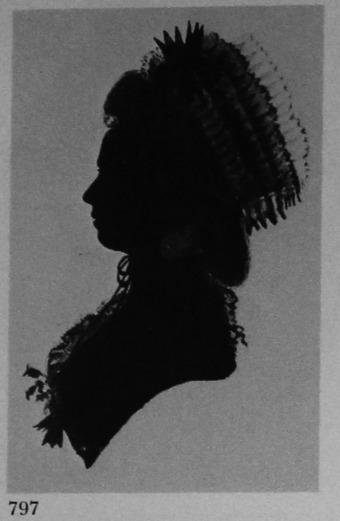
Woman, name unknown, member of the artist’s family
Silhouette painted on card
c. 1780
5½ x 3½in./140 x 90mm.
Crown Copyright. Victoria and Albert Museum, No. E23279-1957
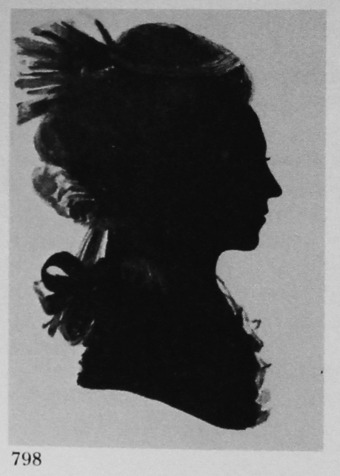
Woman, name unknown, member of the artist’s family
Silhouette painted on card
Soon after 1780
5½ x 3½in./140 x 90mm.
Note the variation of the bust-line termination on this silhouette.
Crown Copyright. Victoria and Albert Museum, No. E23278-1957
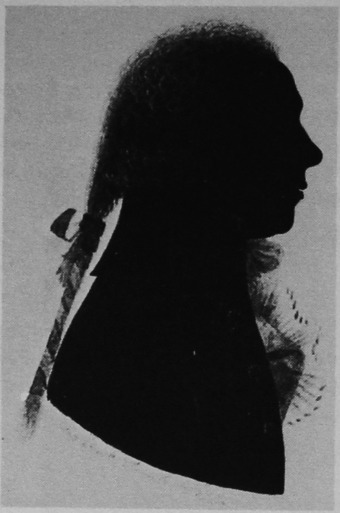
Man, name unknown, member of the artist’s family
Silhouette painted on card
c. 1785
5½ x 3½in./140 x 90mm.
Signed below the bust-line, ‘Friend, Tunb. Wells.’
Crown Copyright. Victoria and Albert Museum, No. E23277-1957
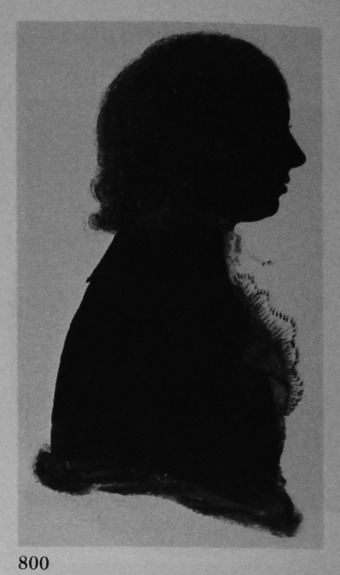
Boy, name unknown, member of the artist’s family
Silhouette painted on card
c. 1785
5½ x 3½in./140 x 90mm.
Signed below the bust-line, ‘Rob. Friend, T. Wells.’
Crown Copyright. Victoria and Albert Museum, No. E23276-1957I
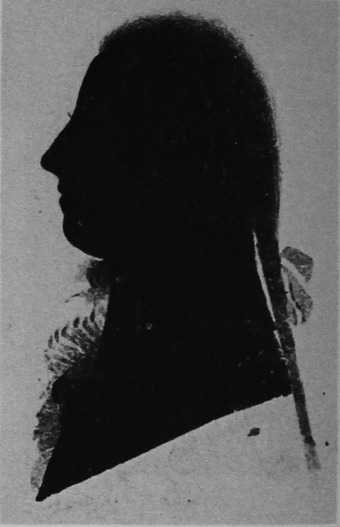
Unknown man
Silhouette painted on card
Early 1780s
5½ x 3½in./140 x 90mm.
Signed on the reverse, ‘Friend Tunbridge Wells’ (the inscription, in an immature hand, illustrated in 804).
Crown Copyright. Victoria and Albert Museum, No. E2637-1953
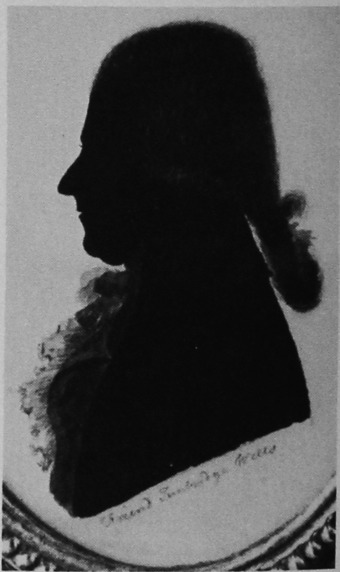
Unknown man
Silhouette painted on card
c. 1786-88
3¾ x 2¾in./96 x 70mm.
Trade Label No. 1
Frame: oval, hammered brass
Signed below the bust-line, ‘Friend Tunbridge Wells’.
M. A. H. Christie collection
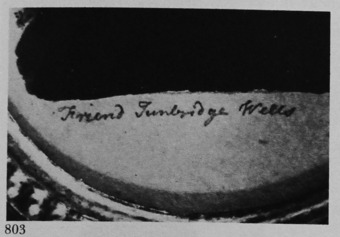
Typical signature of Robert Friend, below the bust-line of a silhouette (802) backed by the artist’s
Trade Label No. 1
M. A. H. Christie collection
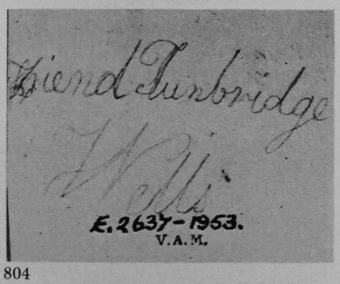
Inscription on the reverse of the silhouette (c. 1785) by Robert Friend illustrated in 801. The handwriting seems remarkably unsophisticated for an artist capable of the finished technique of painting exhibited in the silhouette itself.
Crown Copyright. Victoria and Albert Museum, No. E2637-1953
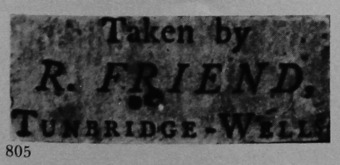
Trade Label No. 1 of Robert Friend, probably used later in his career than the handwritten inscription illustrated in 804.
From the silhouette illustrated in 803.
M. A. H. Christie collection
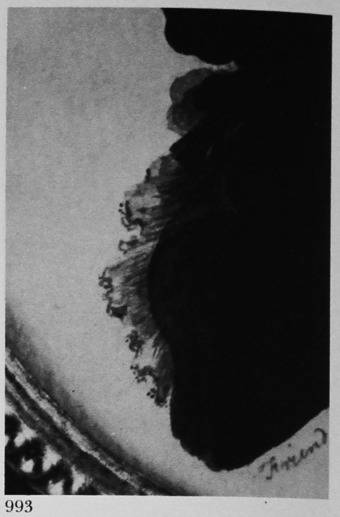
Man’s shirt-frill. Detail from a silhouette by Robert Friend. (802)
M. A. H. Christie collection
